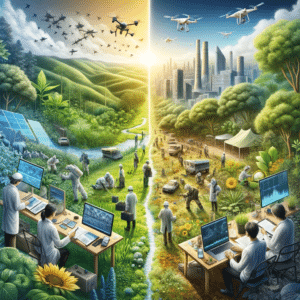Environmental assessment is at a critical juncture, facing transformative changes as it addresses escalating environmental challenges. Discover how the future of environmental assessment could save our planet! This blog post explores the dynamic evolution within the field, spotlighting innovative trends and groundbreaking predictions poised to revolutionize this essential area. By weaving in cutting-edge technologies and adopting holistic, sustainable strategies, we offer an in-depth look at the upcoming shifts destined to enhance the efficacy and impact of environmental assessments in tackling today’s urgent environmental issues.
Environmental Assessment Revolutionized: Embracing Technology, Advancing Science, and Fostering Collaboration
The landscape of environmental assessment is undergoing a transformative shift, powered by rapid advancements in technology and a deepening understanding of ecological systems. This revolution is not just about new tools and data, but also about an evolving mindset that prioritizes collaboration and multidisciplinary approaches. From high-resolution satellite imagery to advanced computer modeling, these technologies are enhancing our ability to assess environmental impacts with unprecedented precision and speed.
- Innovative Sensor Technologies:
The integration of advanced sensor technologies is a significant leap forward. These sensors, deployed in various environments, from urban areas to remote wilderness, provide real-time data on air and water quality, soil health, and wildlife activity. This live data stream allows for immediate response to environmental changes, ensuring that assessments are based on the most current conditions.
- Collaborative Platforms for Data Sharing:
Developing collaborative platforms where scientists, policymakers, and the public can access and contribute to environmental data pools is crucial. These platforms encourage transparency and inclusivity, making environmental data more accessible and fostering a community-based approach to environmental monitoring and decision-making.
- Advanced Climate Modeling:
Utilizing advanced climate models offers detailed predictions about future environmental conditions. These models, fed by vast datasets, can simulate potential scenarios, aiding in understanding the long-term impacts of climate change on different ecosystems and informing strategies to mitigate these effects.
- Integration of Indigenous Knowledge:
Recognizing and integrating indigenous knowledge and practices into environmental assessments brings a valuable perspective that has been honed over centuries. This approach acknowledges the deep understanding that indigenous communities have of their local environments and ensures that assessments are more holistic and culturally sensitive.
- Cross-Disciplinary Research Teams:
Establishing cross-disciplinary research teams combines expertise from different fields such as ecology, sociology, technology, and economics. This diversity in perspectives and skills enriches the assessment process, ensuring comprehensive solutions that address multiple facets of environmental issues.
At the same time, there’s a growing emphasis on fostering collaboration among scientists, policymakers, and communities, ensuring that environmental assessments are not only accurate but also inclusive and comprehensive.
Proactive Environmental Assessment: Leveraging Big Data, AI, and Social Considerations
In the realm of environmental assessment, the proactive use of Big Data and Artificial Intelligence (AI) is a game-changer.
- Predictive Analysis for Ecosystem Health:
Employing AI and Big Data in predictive analyses can forecast changes in ecosystem health. This approach can identify potential threats before they become critical, allowing for preventative measures rather than reactive responses.
- Social Media as a Data Source:
Utilizing social media platforms as a source of environmental data, particularly in assessing public opinion and awareness on environmental issues, provides a valuable insight into the societal impact and public perception of environmental policies and changes.
- AI in Species Conservation:
AI technology is being used to track and analyze the movement and health of wildlife populations. This application is crucial in species conservation, helping to identify patterns and threats to biodiversity.
- Customized Environmental Impact Reports:
Developing customized environmental impact reports using AI algorithms can cater to specific regional or industry needs. These reports can provide detailed analysis and recommendations tailored to the unique environmental and social contexts of different areas or sectors.
- Ethical AI Use in Environmental Studies:
Ensuring ethical use of AI in environmental assessments is critical. This involves transparent algorithms, unbiased data sets, and consideration of privacy concerns, especially when dealing with sensitive environmental and personal data.
Future-Proofing Decision-Making: Integrating Environmental Assessment into Sustainable Development
Incorporating environmental assessments into the fabric of sustainable development is essential for future-proofing decision-making processes. This integration means that environmental considerations are not an afterthought but a foundational aspect of planning and development.
- Sustainable Urban Planning Tools:
Developing tools for sustainable urban planning that incorporate environmental assessments in the early stages of urban development. These tools can help in designing cities that are not only efficient and livable but also environmentally friendly and resilient.
- Renewable Energy Impact Assessments:
Conducting comprehensive environmental assessments for renewable energy projects, such as solar farms and wind turbines. These assessments are vital in ensuring that the shift to renewable energy sources does not inadvertently harm local ecosystems.
- Carbon Footprint Analysis for Industries:
Implementing thorough carbon footprint analyses for industries, assisting them in identifying and reducing their environmental impact, particularly in terms of CO2 emissions. This analysis is a crucial step in moving towards a more sustainable industrial sector.
- Ecosystem Services Valuation:
Incorporating ecosystem services valuation into environmental assessments to quantify the benefits that ecosystems provide to humans. This valuation is key in making informed decisions that consider both economic and ecological sustainability.
- Long-term Environmental Monitoring Programs:
Establishing long-term environmental monitoring programs to track the impacts of development projects. These programs ensure that any unforeseen environmental impacts are identified and addressed promptly, securing the sustainability of the projects in the long run.
Communication and Engagement: Bridging the Gap Between Science and Society in Environmental Assessment
Effective communication and public engagement are critical in bridging the gap between scientific research and societal needs. Environmental assessments must be communicated in ways that are accessible and engaging to the public. This includes:
- Interactive Digital Platforms for Community Engagement:
Developing interactive digital platforms that facilitate active community participation in environmental decision-making processes. These platforms can host virtual town halls, surveys, and forums, allowing for broader public engagement and input into environmental policies and assessments.
- Educational Outreach Programs:
Implementing educational outreach programs that focus on raising awareness about environmental issues and the importance of assessment processes. Tailoring these programs to different age groups and communities ensures a wide-reaching impact and fosters a more environmentally conscious society.
- Storytelling Techniques in Environmental Communication:
Utilizing storytelling techniques to make environmental data and assessments more relatable and engaging to the general public. By presenting information through narratives, complex scientific concepts can be made more accessible and memorable.
- Localized Environmental Impact Visualizations:
Creating localized environmental impact visualizations using GIS and other mapping tools. These visualizations can graphically display potential environmental changes and impacts, making them more understandable to non-experts and aiding in community discussions and decision-making.
- Multi-language Resources for Diverse Communities:
Providing environmental assessment materials and resources in multiple languages to cater to diverse linguistic groups. This approach ensures that language barriers do not impede public understanding and participation in environmental issues.
Navigating Ethical Frontiers: Ensuring Fairness, Equity, and Responsibility in Environmental Assessment
As environmental assessment technologies and methodologies advance, so do the ethical considerations. It’s crucial to ensure that these assessments are conducted with fairness and equity, particularly when considering the impacts on marginalized communities. This ethical dimension also extends to the global scale, as seen in international considerations like the environmental impact assessments in South Africa, which often set benchmarks for developing nations. Ensuring responsibility in environmental assessments means considering the long-term impacts of decisions and prioritizing the well-being of all affected communities.
- Inclusive Assessment Processes:
Ensuring that environmental assessment processes are inclusive and consider the needs and voices of all stakeholders, especially marginalized and indigenous communities. This inclusivity is key to achieving equitable and just outcomes in environmental decision-making.
- Ethical Guidelines for Environmental Assessors:
Developing and implementing ethical guidelines for environmental assessors to follow. These guidelines should emphasize fairness, transparency, and responsibility, ensuring that assessments are conducted with the highest ethical standards.
- Impact Assessments in Developing Nations:
Focusing on environmental impact assessments in developing nations, like South Africa, where the balance between development and environmental preservation is crucial. These assessments must be conducted with an understanding of the local context and respect for local communities and ecosystems.
- Addressing Climate Justice:
Addressing climate justice in environmental assessments by considering how environmental changes disproportionately affect different communities, especially in terms of CO2 emissions and their impact on climate change. This approach involves assessing and mitigating the inequities faced by vulnerable populations.
- Transparent Reporting and Accountability:
Establishing systems for transparent reporting and accountability in environmental assessments. This transparency not only builds trust among stakeholders but also ensures that responsible parties are held accountable for their environmental impacts.
The future of environmental assessment is one marked by technological innovation, proactive strategies, sustainable integration, effective communication, and strong ethical standards. As iEnvironmental Australia, we are at the forefront of these exciting developments, committed to providing our clients with the most advanced and responsible environmental consulting services. We invite our readers to engage with these ideas, share their thoughts, and join us in shaping a more sustainable and equitable future.



